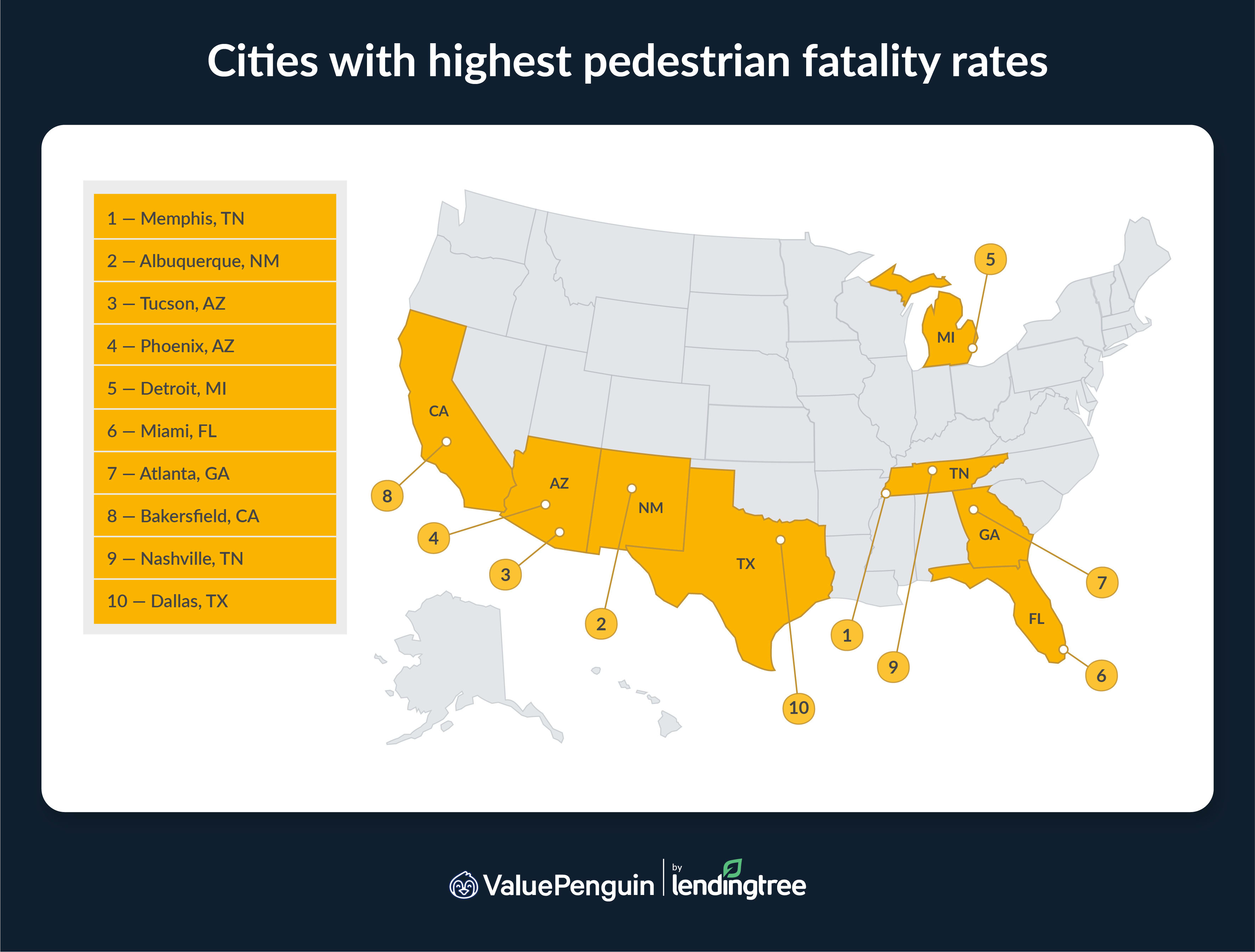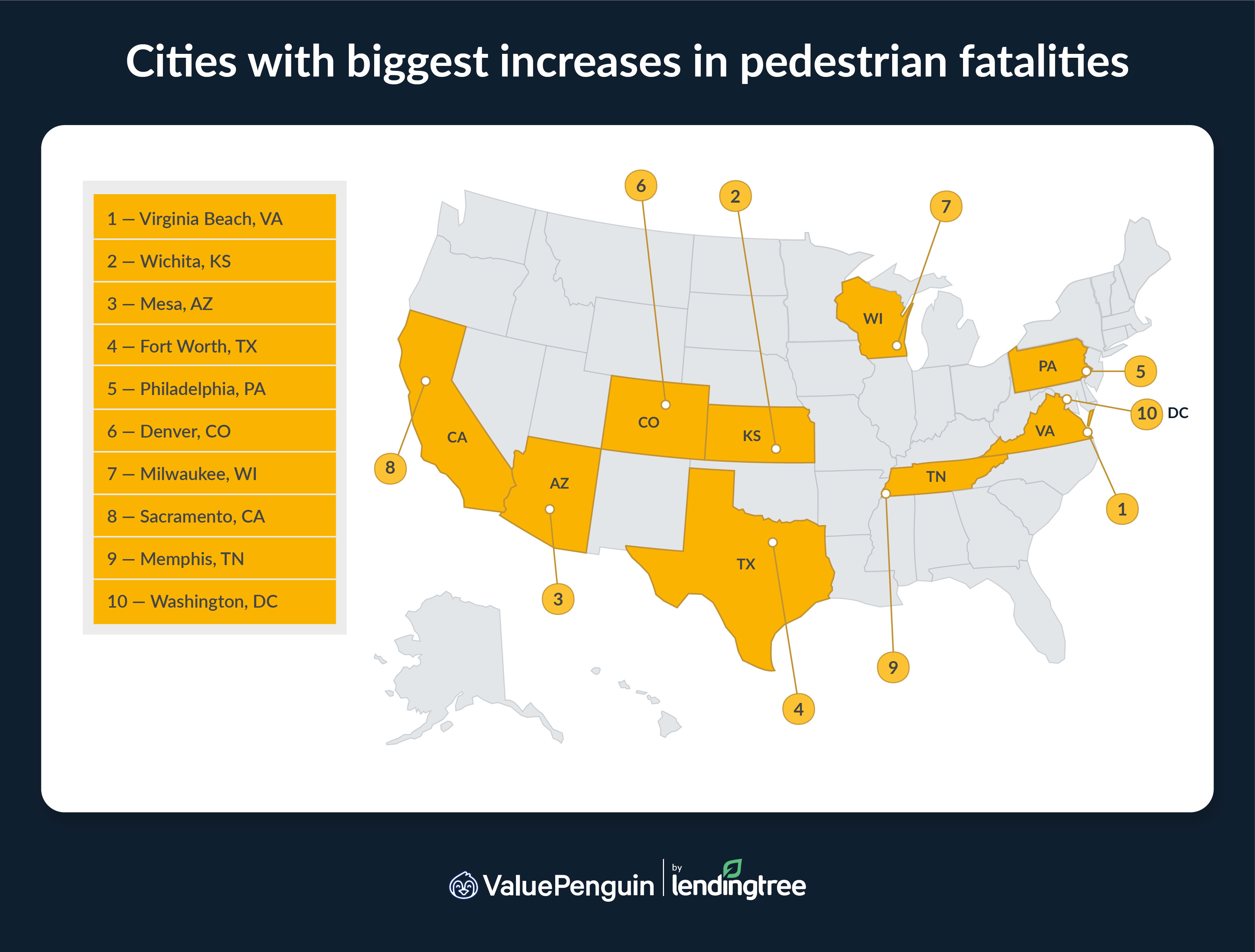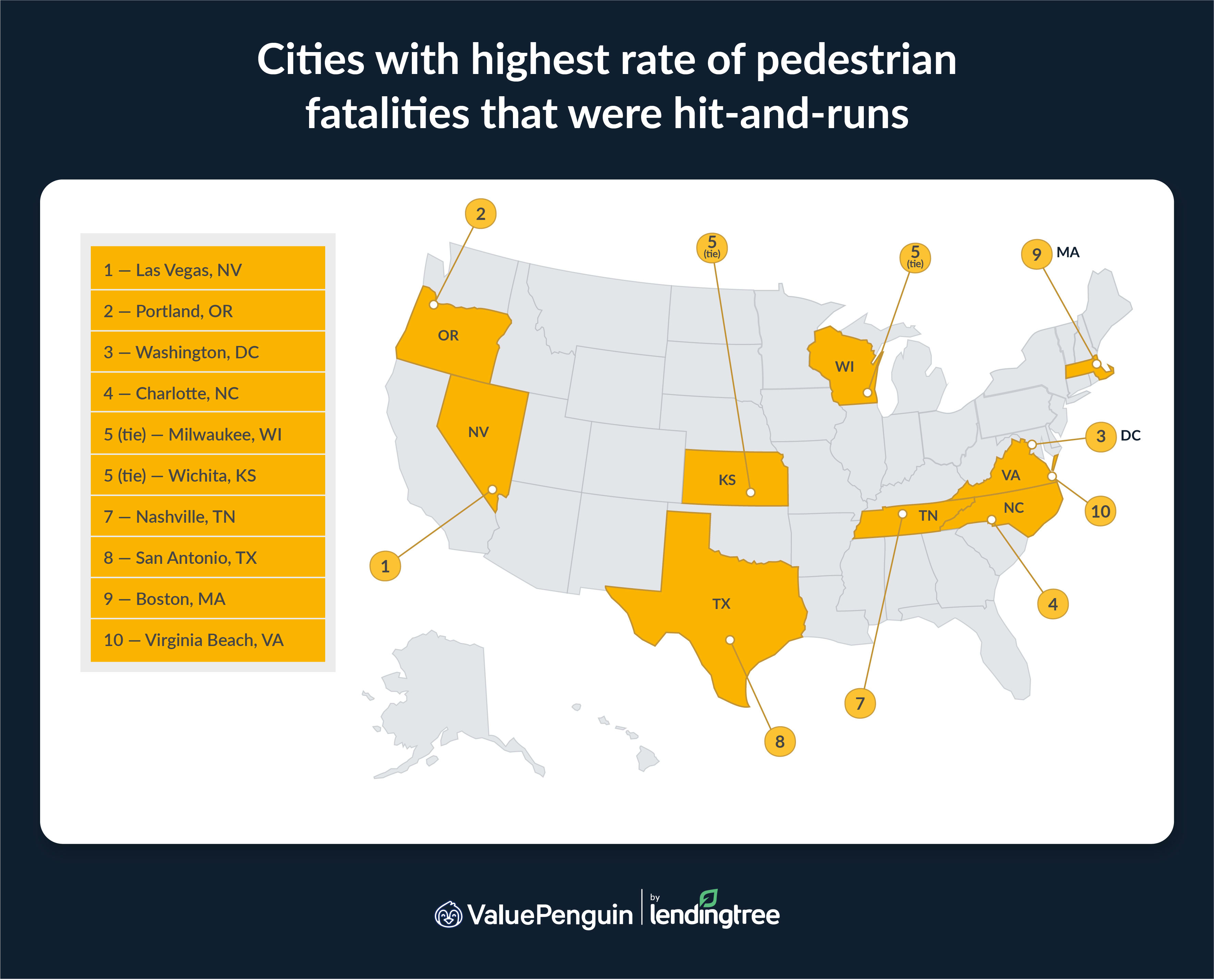Auto Insurance
Pedestrian Fatalities Are Up — Here Are the Most Dangerous Cities

A word of caution for walkers: Pedestrian deaths are up. Pedestrian fatalities rose 16.0% over five years in the 50 biggest U.S. cities by population, climbing from 1,371 in 2019 to 1,591 in 2023, according to a ValuePenguin study.
We analyzed pedestrian fatalities and pedestrian hit-and-run fatalities from 2019 to 2023 (the most recent year for which data is available) in our nation’s most populous cities. We delved into which of these cities’ streets proved most dangerous for those on foot during this time, possible reasons why and more.
On this page
- Key findings
- Pedestrian fatalities up, pedestrian hit-and-run fatalities down
- Memphis, Tenn., has highest pedestrian fatality rate
- 5 cities saw pedestrian fatalities at least double
- Las Vegas has highest rate of pedestrian fatalities that are hit-and-runs
- Car insurance and pedestrian accidents: 5 things to know
- Methodology
Key findings
- The biggest U.S. cities saw a 16.0% increase in pedestrian fatalities over five years. The 50 biggest saw 1,371 pedestrian fatalities in 2019, rising to 1,591 in 2023 — the latest available year. This is significantly below the five-year peak in 2022 of 1,824.
- Pedestrian hit-and-run fatalities slightly decreased over the same period. Across those same 50 cities, 51 pedestrian hit-and-run fatalities occurred in 2019, dipping 3.9% to 49 in 2023. Once again, 2022 saw the highest amount (69) in this period.
- Memphis, Tenn., has the highest pedestrian fatality rate among the biggest cities. At 46.6 per 100,000 residents from 2019 to 2023, Memphis is significantly above the 50-city average of 15.6. Albuquerque, N.M. (37.3), and Tucson, Ariz. (37.2), follow.
- Five of these cities saw pedestrian fatalities at least double over five years. Virginia Beach, Va., saw the biggest jump (350.0%) from 2019 to 2023, surpassing Wichita, Kan. (233.3%), Mesa, Ariz. (133.3%), Fort Worth, Texas (105.0%), and Philadelphia (100.0%).
- Las Vegas had the highest rate of pedestrian fatalities that were hit-and-runs. 17.2% of its 64 pedestrian fatalities from 2019 to 2023 were hit-and-runs. This was also most common in Portland, Ore. (13.1%), and Washington, D.C. (11.9%).
Pedestrian fatalities up, pedestrian hit-and-run fatalities down
In America’s 50 biggest cities, the streets have gotten more dangerous for pedestrians in recent years. These most populous cities saw a 16.0% increase in pedestrian fatalities over five years from 2019 to 2023, according to data analyzed from the National Highway Traffic Safety Administration (NHTSA) Fatality Analysis Reporting System (FARS).
In 2019, there were 1,371 pedestrian fatalities in the 50 biggest cities. In 2023, there were 1,591. However, the 2023 number is down significantly from the five-year peak of 1,824 in 2022.
In general, traffic fatalities from all types of accidents have increased due to distracted driving and speeding, among other things. As for the spike in 2022, Rob Bhatt, ValuePenguin auto insurance expert and licensed insurance agent, says it’s likely linked to the COVID-19 crisis.
"We saw a spike in bad driving out of the pandemic," Bhatt says. "During the shutdowns, drivers developed bad habits on uncrowded roads, including speeding, driving impaired and texting while driving. It took more than a year for people to unlearn these bad habits after roads filled up again. Things began to turn around near the end of 2022, and accidents have declined since."
Changes in pedestrian fatalities in America's biggest cities
Year | Pedestrian fatalities | % change from prior year | % change from 2019 |
|---|---|---|---|
| 2019 | 1,371 | - | - |
| 2020 | 1,441 | 5.1% | 5.1% |
| 2021 | 1,636 | 13.5% | 19.3% |
| 2022 | 1,824 | 11.5% | 33.0% |
| 2023 | 1,591 | -12.8% | 16.0% |
Source: ValuePenguin analysis of National Highway Traffic Safety Administration (NHTSA) Fatality Analysis Reporting System (FARS) data. Note: The largest cities were identified via the U.S. Census Bureau 2023 American Community Survey (ACS) with five-year estimates.
Some better news from city streets: During the same five years, pedestrian hit-and-run fatalities (those in which the driver leaves the accident site without stopping) slightly decreased. Across the 50 largest cities, 51 pedestrian hit-and-run fatalities occurred in 2019. That number dipped 3.9% to 49 in 2023. Once again, however, there was a spike (69) in 2022, which is again likely linked to the aforementioned pandemic driving habits.
Changes in pedestrian hit-and-run fatalities in America's biggest cities
Year | Pedestrian hit-and-run fatalities | % change from prior year | % change from 2019 |
|---|---|---|---|
| 2019 | 51 | - | - |
| 2020 | 54 | 5.9% | 5.9% |
| 2021 | 61 | 13.0% | 19.6% |
| 2022 | 69 | 13.1% | 35.3% |
| 2023 | 49 | -29.0% | -3.9% |
Source: ValuePenguin analysis of NHTSA FARS data. Note: The largest cities were identified via the Census Bureau 2023 ACS with five-year estimates.
Memphis, Tenn., has highest pedestrian fatality rate
"Walking in Memphis" may be a catchy soft rock tune, but walking in Memphis is more dangerous than in any other big U.S. city. Memphis had the highest pedestrian fatality rate among the 50 biggest cities over the five years ending in 2023. While the 50-city average was 15.6 per 100,000 residents (7,863 total), Memphis saw a rate of 46.6 pedestrian fatalities per 100,000 residents during that time.

Studies have shown pedestrian injuries (not just fatalities) are more likely to involve Black, indigenous and people of color and those with lower incomes — and Memphis checks both boxes. According to World Population Review, Memphis’s population is 62.9% Black or African American, and the poverty rate is 22.54%.
Following Memphis with the next-highest pedestrian fatality rates from 2019 to 2023 were Albuquerque, N.M. (37.3), and Tucson, Ariz. (37.2). Other factors that likely contribute to higher pedestrian fatality rates include a city’s infrastructure, local driving and walking habits, and law enforcement practices.
Cities with highest/lowest pedestrian fatality rates
Rank | City | Pedestrian fatalities, 2019-23 | Fatalities per 100,000 residents |
|---|---|---|---|
| 1 | Memphis, TN | 293 | 46.6 |
| 2 | Albuquerque, NM | 210 | 37.3 |
| 3 | Tucson, AZ | 202 | 37.2 |
| 4 | Phoenix, AZ | 479 | 29.5 |
| 5 | Detroit, MI | 186 | 29.2 |
| 6 | Miami, FL | 129 | 28.9 |
| 7 | Atlanta, GA | 139 | 27.8 |
| 8 | Bakersfield, CA | 106 | 26.0 |
| 9 | Nashville, TN | 173 | 25.3 |
| 10 | Dallas, TX | 323 | 24.9 |
| 11 | Fresno, CA | 132 | 24.3 |
| 12 | Sacramento, CA | 122 | 23.2 |
Source: ValuePenguin analysis of 2019-23 NHTSA FARS data. Note: The largest cities were identified via the Census Bureau 2023 ACS with five-year estimates.
The Big Apple had the lowest pedestrian fatality rate — 3.3 per 100,000 residents — from 2019 to 2023. Following are Boston (5.9) and Virginia Beach, Va., and Omaha, Neb. (both 6.1).
5 cities saw pedestrian fatalities at least double
Still looking at the five years from 2019 to 2023 — when the 50 biggest cities had an average 16.0% increase in pedestrian fatalities — some individual cities had far higher fatality numbers at the end of the period than during the start. In fact, five cities saw pedestrian fatalities at least double from 2019 to 2023:
- Virginia Beach, Va.: 350.0%
- Wichita, Kan.: 233.3%
- Mesa, Ariz.: 133.3%
- Fort Worth, Texas: 105.0%
- Philadelphia: 100.0%

Of course, a high percentage increase doesn’t necessarily mean a high number of fatalities. When the total number of pedestrian fatalities is small, even a slight change can have a significant impact. For example, while Virginia Beach saw the biggest percentage increase in pedestrian fatalities over the five years, it had the smallest total number of pedestrian fatalities in 2019 (two) and the fifth-smallest in 2023 (nine).
Similarly, the city with the highest decrease in pedestrian fatalities during that time — Omaha, Neb. — saw six in 2019 and just three in 2023, a 50.0% drop. Overall, 11 cities, including Omaha, saw a decrease in pedestrian fatalities during that time.
Cities with biggest increases/decreases in pedestrian fatalities
Rank | City | Pedestrian fatalities, 2019 | Pedestrian fatalities, 2023 | % change |
|---|---|---|---|---|
| 1 | Virginia Beach, VA | 2 | 9 | 350.0% |
| 2 | Wichita, KS | 3 | 10 | 233.3% |
| 3 | Mesa, AZ | 6 | 14 | 133.3% |
| 4 | Fort Worth, TX | 20 | 41 | 105.0% |
| 5 | Philadelphia, PA | 28 | 56 | 100.0% |
| 6 | Denver, CO | 16 | 28 | 75.0% |
| 7 | Milwaukee, WI | 11 | 18 | 63.6% |
| 8 | Sacramento, CA | 16 | 26 | 62.5% |
| 9 | Memphis, TN | 36 | 57 | 58.3% |
| 10 | Washington, DC | 9 | 14 | 55.6% |
| 11 | Arlington, TX | 6 | 9 | 50.0% |
| 12 | Indianapolis, IN | 21 | 31 | 47.6% |
Source: ValuePenguin analysis of 2019-23 NHTSA FARS data. Note: The largest cities were identified via the Census Bureau 2023 ACS with five-year estimates.
Las Vegas has highest rate of pedestrian fatalities that are hit-and-runs
Next, we calculated the percentage of pedestrian fatalities that were hit-and-runs from 2019 to 2023 in the same biggest cities.
Across the 50 cities, 3.6% of the 7,863 pedestrian fatalities from 2019 to 2023 were hit-and-runs. Some cities had significantly higher rates, with Las Vegas topping the list — 17.2% of its 64 pedestrian fatalities from 2019 to 2023 were hit-and-runs.
The nonstop nightlife of "Sin City" is likely a factor, as many hit-and-run accidents involve alcohol and late-night hours.

Portland, Ore., followed with 13.1% of its 107 pedestrian fatalities classified as hit-and-runs, and Washington, D.C., with 11.9% of its 67 pedestrian fatalities classified as such.
Some cities show zero hit-and-run pedestrian fatalities during this time. Our study is based on FARS data, and it’s unclear whether these cities saw none or if the data was unavailable.
Cities with highest/lowest rate of pedestrian fatalities that were hit-and-runs
Rank | City | Pedestrian fatalities, 2019-23 | Pedestrian hit-and-run fatalities, 2019-23 | % that were hit-and-runs |
|---|---|---|---|---|
| 1 | Las Vegas, NV | 64 | 11 | 17.2% |
| 2 | Portland, OR | 107 | 14 | 13.1% |
| 3 | Washington, DC | 67 | 8 | 11.9% |
| 4 | Charlotte, NC | 128 | 15 | 11.7% |
| 5 | Milwaukee, WI | 84 | 8 | 9.5% |
| 5 | Wichita, KS | 42 | 4 | 9.5% |
| 7 | Nashville, TN | 173 | 16 | 9.2% |
| 8 | San Antonio, TX | 319 | 25 | 7.8% |
| 9 | Boston, MA | 39 | 3 | 7.7% |
| 10 | Virginia Beach, VA | 28 | 2 | 7.1% |
| 11 | Houston, TX | 470 | 31 | 6.6% |
| 12 | Atlanta, GA | 139 | 9 | 6.5% |
Source: ValuePenguin analysis of 2019-23 NHTSA FARS data. Note: The largest cities were identified via the Census Bureau 2023 ACS with five-year estimates.
Car insurance and pedestrian accidents: 5 things to know
If you’re involved in a fatal pedestrian accident, there are legal consequences, and you’ll likely need an attorney to help you navigate the process. In the case of a nonfatal car-pedestrian accident, important insurance considerations can save you time, money and stress.
Here are five things to keep in mind if you’re involved in a car-pedestrian accident:
- Call law enforcement. If someone is seriously injured, call 911 for medical help. You should also render aid if it’s safe to do so and remain at the scene until help arrives. Even if the injuries appear less severe, most states require a police report for any accident that results in bodily injury. At a minimum, the driver and pedestrian should exchange contact and insurance information. However, Bhatt suggests that both parties are better off calling law enforcement to the scene to obtain the necessary information for investigation.
- Document. Document the scene for yourself with your smartphone. Note the location and direction the car was traveling, as well as nearby traffic signals, stop signs and/or crosswalks. You should also capture images of any vehicle damage and/or visible injuries — whether you are the pedestrian or the driver. This information can be crucial as you go through the insurance process.
- Watch your words. It's generally best to avoid admitting fault at the scene of an accident. "In the heat of the moment, you may not notice evidence that may have contributed to the accident, but it’s best not to blurt anything out," Bhatt says. "Let the law enforcement professionals follow their protocols, and provide them with honest, accurate information when asked." He says it’s also good to jot down a few notes about the accident at the earliest opportunity. Note the location, time of day and sequence of events leading to the accident, as well as your observations about the scene and any injuries or damage that occurred.
- Know your liability limits. It can take days or weeks to determine who is at fault for an accident. If a driver is wholly responsible, their car insurance liability coverage pays for the injured pedestrian’s medical bills — up to the driver's liability limits. However, an injured pedestrian may have to make initial payments for their medical treatment while the accident is investigated. Depending on your state, an at-fault driver's liability payment may be reduced if the pedestrian is partially responsible for the accident. However, if an at-fault driver doesn't have enough liability insurance to cover a victim's medical expenses, they can be held personally responsible for the shortfall. This is one of the main reasons to consider higher liability limits in your car insurance policy.
- Track your injuries and expenses. If you're injured while walking, your car insurance may cover your initial medical expenses — especially if your policy includes personal injury protection (PIP) or medical payments (MedPay). If not, your health insurance can help with your initial medical payments, though you may still have to cover deductibles and copayments out of your pocket. Be sure to document your medical expenses and keep a record of the amount you and your insurance company paid for treatment. You and your insurance company can usually recoup these initial costs from an at-fault driver's insurance company once the accident investigation is complete and fault is determined. An injured pedestrian can typically recover physical therapy costs, lost wages and nonmonetary damages like pain and suffering from an at-fault driver, usually through the driver's insurance company. You may want to contact an attorney for help securing the funds you need to recover from your injuries.
Methodology
ValuePenguin researchers analyzed and combined multiple National Highway Traffic Safety Administration (NHTSA) Fatality Analysis Reporting System (FARS) datasets to calculate pedestrian and pedestrian hit-and-run fatality statistics from 2019 through 2023.
The U.S. Census Bureau 2023 American Community Survey (ACS) with five-year estimates was used to identify the 50 biggest cities by population in the U.S. Additionally, each city's population was used to calculate the pedestrian fatality rate per 100,000 residents in the same 2019-to-2023 period.
